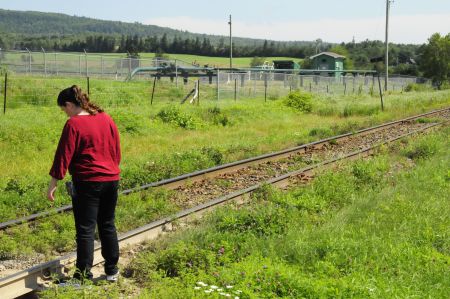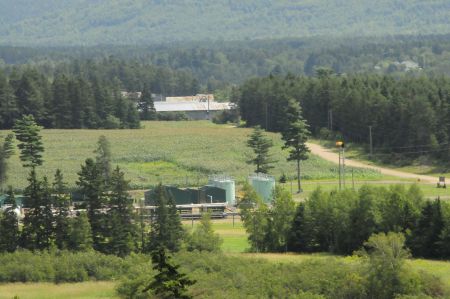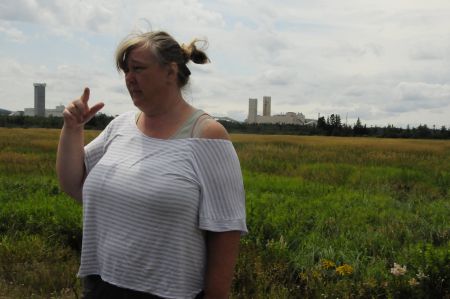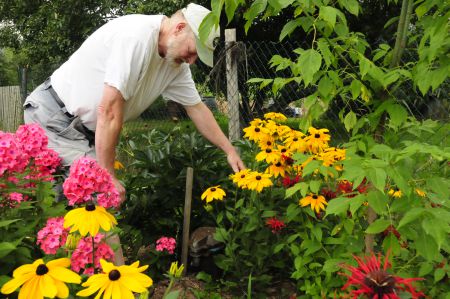Grey geometrical towers block out tetris-like patterns against the rural landscape in a small New Brunswick village. They are marked by a sign: Potash Corporation, New Brunswick, just past the sign for Animaland, a now defunct concrete sculpture theme park on highway no. 114.
Welcome to Penobsquis, a small town of about 100 households.
On the surface, it's a typical farming town in New Brunswick: rolling green fields are dotted with golden hay bales and white homesteads.
But two corporations have left an indelible impact on the town. Potash Corporation of Saskatchewan has mined there for 30 years. Corridor Resources, a junior oil and gas company, and Potash Corp jointly own the wells on the natural gas reserve known as the McCully Field.
A gas line snakes under the Kennebecasis River, running gas from well pads – which sit on many private farms in the area – to the Bay of Fundy.
Gas flares lick the air, sometimes plenty of metres high.
The waitress at the sole breakfast joint in town greets visitors – mainly gas workers and farmers – with her jovial remark: “I'm the cook, the maitre d', the waitress and the busboy.”
Potash Corp and Corridor work together to the point that they can easily play residents' complaints off each other, say local residents Heather McCabe and Beth Nixon. Natural gas feeds the potash mills, and what is left is shipped to New England through the Maritimes & Northeast Pipeline. Ninety-five per cent of the potash is shipped to markets in the Caribbean and South America.
When the mines flooded in the late 1990s and companies began seismic testing for mineral deposits and natural gas, the first natural springs started to dry up.
Stewart Brown, general manager of Potash Corp New Brunswick, says “nothing is definitive in terms of cause and effect” among these activities.
All in all, about 60 homes in the area lost their water.
* * *
McCabe, a 42-year-old who works in a warehouse, was the last one to lose her well in 2007, but she was one of the lucky ones since her home sat on top of an aquifer.
She also experienced “subsidence,” or displacement – her property sank 0.75 metres and moved sideways by half a metre toward the TransCanada highway. Her roof dips at certain points. She reports her house lost $50,000 in assessed value.
There is no insurance to cover the loss of water or subsidence caused by mining.
Brown says that the amount of subsidence is very minimal and that it also occurred naturally before mining began in the area. Researchers from the University of New Brunswick monitor the subsidence on an annual basis.
“They refer to us as their lab, so does that mean we're lab mice?” jokes McCabe.
When she and others lost their water, Potash Corp financially assisted the provincial government in establishing a regional water supply. The government would deliver large plastic tanks filled with water every two days. Each adult was allowed 15 gallons of water per week.
But water consumption outside of what was deemed regular “household” consumption, whether it be for laundry or pets or gardening, was rigidly policed.
McCabe owns an animal sanctuary and her dogs need drinking water. She was told that her “dogs can drink out of puddles.” She says that contaminants – everything from plastic to grass to feces – have been found in the water system. “They provided no method of keeping the tanks cool in the summer,” she says. “People got rash and contamination because of it.”
The New Brunswick Mining Commissioner heard 16 separate property complaints filed in 2009. Water-related cases were not resolved until 2012, and cases related to subsidence or other concerns were withdrawn by complainants or dismissed due to lack of evidence.
Nixon finds the decisions disputable, because so many lawyers and engineers in the province are employed by the mining or gas industry or have close ties through their firms.
* * *
Beth Nixon has been giving tours in her truck for years and has developed a diplomatic sense of humour about the slow but steady transformation of her town. She likes talking about the “sliding scale” used by corporations and politicians to justify the limits they define for industry.
“There's a sliding scale with fracking,” she opines. “At what stage does it become a problem? I think that's why we need a moratorium to figure it out.”
As we drive down Penobsquis Loop Road, the main residential road in town, she gestures left and right: this home lost its water; so did this one. That home has cracks in the basement; this family found a sinkhole under their swimming pool.
Nixon, a mother of four in her forties, is the third generation to farm a piece of land once owned by her grandparents, sold by her parents, and bought back by her and her husband. Now, her land is too wet to farm because of mining subsidence.
Growing up, Nixon always wanted to farm. She has harvested raspberries and owned her own dairy farm. “If you've dug your hands into the soil that your father and grandfather farmed, you feel attached to the land,” she says. But her frustrations with government's handling of industry in her town proved almost too much.
“I would have left by now, but my husband wanted to stay,” she says.
She opted to have the well pad put on her property because of environmental oversight clauses in the contract – better she be able to monitor the well's impact on her land than it be installed on her neighbour's land, where she would have no control.
Wastewater from the fracking process is treated at the Sussex sewage plant, but Nixon is wary of it leaching into water and soil in the area. “I refuse to buy potting soil and compost (here),” she says. “People are trying to conscientiously grow their own food. I don't know the facts but I don't have enough faith in the government to look into it either.”
She shows us well pad M-66, the site of a grass fire from a flare. “This pad is displacing water onto this (farmer's) field. It's too wet for him to hay.”
Well pad F-67 gives her nightmares. A jungle of above-ground pipelines sits adjacent to railway tracks, at the same spot where a train once derailed. In her eyes, it's a disaster waiting to happen.
There have already been incidents.
In 2006, Corridor spilled 3,000 litres of fracking sand. Never having dealt with a spill before, the Department of Environment called in the Canadian Nuclear Safety Commission, which ruled there were no health and safety concerns about the mildly radioactive material disposed of in an open pit.
In 2008, a tractor hit a pipeline while plowing a field.
Corridor doesn't frack or drill but contracts the work to other companies, so it's often able to evade allegations of “incidents” through this loophole, according to Nixon and McCabe.
In 2005, drilling caused an explosion which woke many residents at night. For Nixon, this qualifies as an “incident.” As for Corridor, they featured photos of the explosion on the front page of their annual report to investors (see photo at right.)
* * *
Both McCabe and Nixon say they have received threats from others in the community, mainly from those worried about their jobs or pensions.
“They're bullying their way through our town,” says Nixon. “How much personal loss are you supposed to take so your neighbours have jobs? Properties have devalued, farmlands lost. You've got to compensate people for their losses, not just pound them into the dirt for money.”
“I'm not anti-fracking or anti-shale but I think these stories need to be told so each community can decide for themselves.”
Well pads, one kilometre apart, leave little room for traditional hunting because, as signs indicate, no such activity is permitted within 400 meters. This poses a problem for indigenous groups – Penobsquis is part of Siknitook territory on Mi'kmaq land.
Industry has brought a certain level of prosperity to the community. After an association formed to build a community playground, Corridor chipped in. You can see the McCully Gas Plant from the swing set. Potash Corp has recently committed $1 million to build a pool at the civic centre. There are scholarships, and jobs with benefits.
Potash Corp employs 600 employees, mainly area residents, at its existing operations, and a further 250 people are working to construct the new Picadilly mine, a $2 billion long-term investment according to Brown. Corridor directly employs 30 people and has numerous contractors.
But mining along the McLeod family farm, a seven-generation Jersey farm where we conclude our tour, has turned the fields into marsh. Potash Corp has mined along the property since the early '70s. Corridor has been there since 2006.
“They're exporting gas now, but who's going to take out the pipelines when they're done?” asks Nixon. “A lot of people have invested in this industry, but mainly politicians and industry owners are getting rich off it. Farmers have looked after these properties for seven generations and want them here for seven more, but now they've been damaged forever.”
* * *
Wayne Bell, a 61-year-old truck driver, lives on an acre of land which used to be served by three springs which predate Bell himself. You wouldn't be able to tell if he was upset they dried up because of his gentle demeanour. He's happy with his water now but found Potash Corp “very heavy handed for lack of a better word.”
“We had to fight to get enough water for laundry. They said laundry was not part of daily household use,” he recalls. He believes there is subsidence of his property, though it's only been proven for his neighbours. He worries that if the ground is moving, the lateral pipes for his water system are going to break.
Gas exploration has been less of a proverbial headache for Bell, though he notes, “you can definitely smell it and taste it, it's in the air.”
A joint federal and provincial study of air quality as it relates to fracking was conducted over a six-week period, but did not address concerns specific to Penobsquis. Health concerns have not been addressed whatsoever.
Nixon's “sliding scale” appears to apply to environmental monitoring as well. “A well might be leaking, but it doesn't meet industrial standards for (what's considered) a leak,” she says. “One would hope for a different threshold than industrial parks.”
“They may want to do a good job, but they they don't have the right equipment. All kinds of people promised to come here with infrared cameras (to detect gas vents) but no one did.”
Corridor was unable to respond to an interview request by the time of publication. In response to questions regarding air and water quality, a communications advisor for the government of New Brunswick responded via email:
“As is the case with all projects undertaken in our province, ensuring that environmental rules are followed is of the utmost importance.
“The Province of New Brunswick has released additional rules for industry in February 2013 for the exploration and development of oil and natural gas. These include rules that industry must follow in relation to air emissions, protection of water quality, sustainable use of water, etc.”
But rules only provide so much comfort for the residents of Penobsquis. McCabe goes so far as to say the town has become “New Brunswick's dirty little secret.”
For his part, Bell is skeptical about environmental oversight in his town.
“These lads that are pushing the wells, they don't have grandkids that are going to be here when they've left. Where are these people going to be 20, 30 years later when the land and water is contaminated?”








